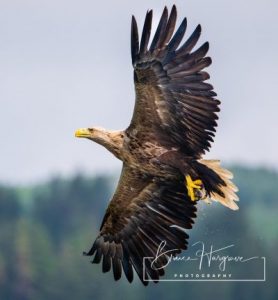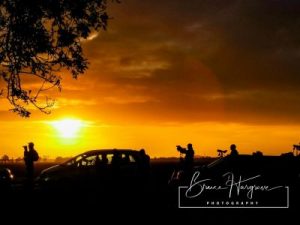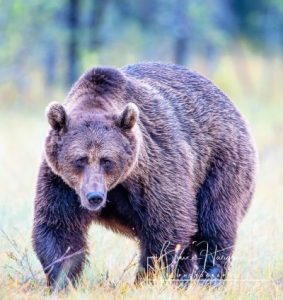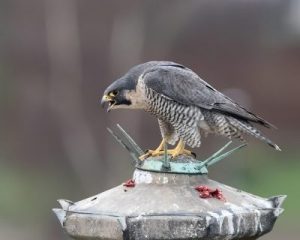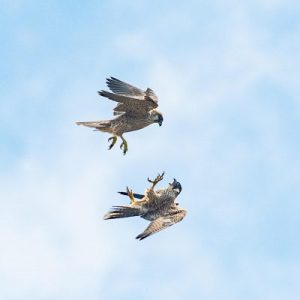Do I have something special for you today! Hopefully by now our passion for nature and specifically capturing the amazing birds of Cuba through our lens has shone through. We love to share our insights on the birds and amazing prints, what we love as much is finding like-minded individuals, coupled with amazing photography skills! Bruce Hargrave happens to be one of those.
Bruce is a professional nature photographer from the UK. I first discovered Bruce’s work when I read his recently published article about the peregrine falcons who make their home on Lincoln Cathedral. Fascinating! If you have a chance, get a copy of his article… And because it was fascinating, I decided to reach out to Bruce to find some synergies, and see if we can bring his expertise to Cuba Photography Tours. Luckily for us, he said yes!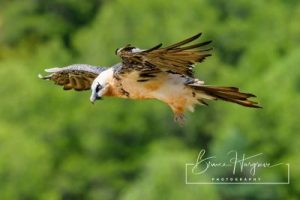
Bruce is going to come along as the photography expert on our 2022 birding tours in Cuba with the mission to share his knowledge and insight with those adventurers who’d like to fine tune their skills in bird photography and want to walk away with a really stunning photography portfolio, along with life long memories of their time in Cuba.
In the meantime, I’ve been chatting to Bruce to pick his brains on his “top tips” for great nature photography….
“If your pictures aren’t good enough, you’re not close enough!” Says Bruce, quoting the great photojournalist Robert Capa with a cheeky chuckle.
I have to say, he may just be onto something… How many times do you go out on a birding photography session and find once you downloaded the pictures to your laptop that the quality is just not there? The birds seem too far away. Or there’s too much noise. Then sometimes, after spending hours on finding the perfect bird through the viewfinder, for the perfect shot, the picture quality actually does turn out to give a breath-taking image. The detail, the colours, the quality… you are just blown away (it’s OK, it happens, you can pat yourself on the back!)
Of course, we all want to have more of those pictures that are truly amazing, even good enough to print and put on the wall. So how can you ensure that these rare events become more common? How can you turn blind luck into a repeatable skill?
Bruce’s been photographing birds and animals for over 45 years and has had his wildlife pictures published in photography magazines and online. No wonder! He takes incredible pictures. Which is why I asked him to share with us his 5 top tips (he even gave us a bonus one) that would give you amazing birding shots each time.
Tip 1 – Practice, practice, practice
“It’s funny, the more I practice, the luckier I get” – the great golfer Arnold Palmer reputedly said this in response to someone telling him how lucky he’d been to hole a tricky 50 yard putt – and this adage holds true for photography as well – says Bruce.
He’s a frequent visitor to Lincoln cathedral in the UK. The cathedral has a resident pair of peregrine falcons that Bruce regularly spends a few hours once or twice a week watching, in the hope of photographing them. A lot of the time, they’re perched high up on one of the towers, digesting their latest prey. Bruce further explains that once he spots them, they aren’t that difficult to photograph, but the resulting images, ‘to be honest, are a bit boring’ – says Bruce. ‘There are only so many ‘long distance peregrine perched on a cathedral’ shots that you can take’ he further explains.
The magic comes when both birds get airborne. ‘At this moment, there’s action! They may have a bit of dogfighting or pigeon chasing. These scenes can produce great images’ – he explains excitedly. As exciting as this is, if he’s missed a few trips to photograph the birds, it takes a few ‘misses’ before Bruce’s reaction time and muscle memory clicks back in again. The pictures that he misses remind him to get back out there and practice, practice, practice.
Tip 2 – Get out there at the right time.
Most wildlife tends to be at its most active at first light (in the morning) and just before last light (in the afternoon or evening). Time spent observing your quarry is never going to be wasted, but if you can only spend limited time with the subject you are trying to photograph, early morning is likely to be the best time. This is true for at least two different reasons, says Bruce, and his reasons are:
- If you’re out early, you’re likely to be one of the first people there. Wildlife tends to be very wary of humans, so if you get there before someone else has had the chance to scare them away then you can wait there quietly in the knowledge that you have given yourself the best chance to see and photograph what you came for.
- Morning light is beautiful. You can’t take photographs without light, but you do get different qualities of light at different times of day. The great thing about morning light is that it tends to be soft and diffuse because the light source (the sun) is low in the sky. The amount of light is also going to be increasing all the time – and this is going to help you with obtaining higher shutter speeds (to freeze the action) without having to resort to bumping up your ISO and reducing image quality. Evening light is beautiful too – the sun is low in the sky again – but the downside of evening photography is that the light levels are going to be steadily reducing and you’ll be chasing the light. Don’t discount an evening visit but, if you have the choice of morning or evening, choose the morning.
Tip 3 – There’s no substitute for local knowledge.
We of course live by this tip ourselves! So were very excited to hear Bruce’s take on local knowledge. He suggests that it really helps to go out with someone with local wildlife knowledge – you’re really giving yourself the best chance possible to see what you came to see. No wonder! A local guide has intimate knowledge of his area.
Whilst Bruce has insider’s knowledge of his own area, he understands that building that knowledge has taken him years. ‘I’m a keen nature photographer’ – he states, but when he is outside of his local area, he doesn’t leave creating the perfect photography opportunity to a chance.
‘I’ll always try to secure the services of a reliable nature guide for the first day of my visit when in the UK. This is going to cost me money but, as I’m only going to be staying there for one or two weeks, it’s a good investment because the guide will show me the current ‘hotspots’ for observing birds and mammals right from the get go. I won’t have to spend precious days building up my ‘non-local’ local knowledge.
If I’m travelling outside the UK, then it’s even more important to find a reputable local guide. I’ll do my research before I go and find out who has the best reputation for the location I’m going to be visiting. Then I’ll make sure that I book that guide for my tour!’
Tip 4 – Fieldcraft is invaluable.
‘The great thing about field craft is that it’s mostly common sense’ – says Bruce. However, it’s also worth remembering that common sense isn’t all that common!
So his tips are to make as little noise as possible. If you’re with a companion, it’s almost second nature to want to talk to them and to point things out to them. Bruce then points out that making noise and waving your arms is a great way to scare wildlife away before you even get a chance to see it.
He also suggests, to cover your hands and face in some sort of drab material. Hands and faces tend to be the bits of us humans that show up best against a natural background, so the more that you can get them to blend in the better. In saying that, full on camo gear may not be the most comfortable thing to wear in tropical surroundings. For that, Bruce recommends lightweight camouflage gloves and hoods that can be bought online fairly cheaply. ‘They take up very little space in your pockets and they work really well!’ – he points out.
Also think about the rest of your clothing, Bruce suggests. ‘ Your bright yellow Gortex coat will keep you dry, but it will also rustle every time you move and stand out like a sore thumb – wildlife will give you a very wide berth!’ – as he points out.
His next note will not apply to a tour, as it is a little different environment, but it is certainly something to consider when you set yourself up to perch for the perfect photograph alone – ‘The great thing about blending in with the environment is that other people are less likely to spot you. The last thing you want when you’re in a great position to photograph wildlife is for someone to wander over and start asking you questions in a loud voice (trust me – it happens!)’.
There could be a drawback to be invisible too. Bruce had the unfortunate experience of having a lady walking her dog squatting down to relieve herself just a couple of yards from the hedge where he had concealed himself! Whoops…
Tip 5 – Take the best gear with you that you can get.
Whilst Bruce agrees with the notion ‘it’s not about how good your gear is, it’s about how good you are as a photographer’, he does point out that, particularly for bird photography, you need good quality gear to take good quality pictures. Especially if you’re on your once in a lifetime trip to photograph a species that you’re never likely to see again. In which case, Bruce’s advice is ‘if you can’t afford to buy it, hire it to maximise your chances of getting great shots.’
As an example where Bruce has done this, he offers up his trip to Finland where he photographed brown bears. ‘I hired a 500mm f4 telephoto prime lens. That’s a £12,000 bit of gear and there was no way I could afford to buy one. Hiring one for a week cost me about £140, but it was well worth it. It enabled me to get some superb images!’
Also remember that it’s not just about camera gear. Always invest in the best footwear that you can afford – and make sure that it fits perfectly. You can endure an awful lot of bodily discomfort if your feet aren’t warm and dry. And you can walk an awful lot further if your feet don’t hurt.
Bonus Tip
Bruce’s final tip moves away from the purely practical to the almost philosophical. The tip is this – Never Lose Your Sense Of Wonder.
In his words: ‘Being out in nature is one of the best things – perhaps the best thing – that we can do for our physical and mental health. Sit still in silence and enjoy it. If it’s a long wait, that’s great! Then you get longer to enjoy it. If the bird or the animal that you came for doesn’t put in an appearance, you had the rest of God’s beauty to look at and photograph while you waited – you have wasted no time at all.’
Time to meet our next expert! Bruce Hargrave
Bruce is a UK based wildlife and nature photographer. He has been interested in cameras in the ages of dark rooms! 😲 His Grandad built him a darkroom in the loft so he could develop and print the black and white photos. Those were the days!
Bruce likes to get out in nature and shoot wildlife photographs in wild places, even better when he can take others with him, so he can teach them how to capture some stunning photos and magical moments.
He brings a vast of experience a budding photographer could take advantage of!
Want to join Bruce on a Birding Photography Tour? Check out the Itineray!

